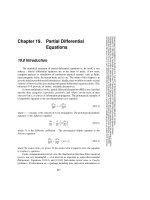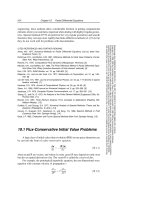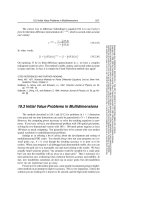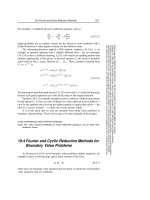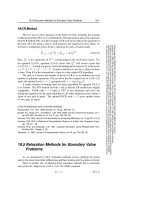Beginning partial differential equations, 3rd edition
Bạn đang xem bản rút gọn của tài liệu. Xem và tải ngay bản đầy đủ của tài liệu tại đây (1.17 MB, 130 trang )
Solutions Manual for
Beginning Partial
Differential Equations
PURE AND APPLIED MATHEMATICS
A Wiley Series of Texts, Monographs, and Tracts
Founded by RICHARD COURANT
Editors Emeriti: MYRON B. ALLEN III, PETER HILTON, HARRY
HOCHSTADT, ERWIN KREYSZIG, PETER LAX, JOHN TOLAND
A complete list of the titles in this series appears at the end of this volume.
Solutions Manual for
Beginning Partial
Differential Equations
Third Edition
Peter V. O’Neil
University of Alabama at Birmingham
Copyright c 2014 by John Wiley & Sons, Inc. All rights reserved
Published by John Wiley & Sons, Inc., Hoboken, New Jersey
Published simultaneously in Canada
No part of this publication may be reproduced, stored in a retrieval system, or transmitted
in any form or by any means, electronic, mechanical, photocopying, recording, scanning, or
otherwise, except as permitted under Section 107 or 108 of the 1976 United States Copyright
Act, without either the prior written permission of the Publisher, or authorization through
payment of the appropriate per-copy fee to the Copyright Clearance Center, Inc., 222
Rosewood Drive, Danvers, MA 01923, (978) 750-8400, fax (978) 750-4470, or on the web at
www.copyright.com. Requests to the Publisher for permission should be addressed to the
Permissions Department, John Wiley & Sons, Inc., 111 River Street, Hoboken, NJ 07030,
(201) 748-6011, fax (201) 748-6008, or online at />Limit of Liability/Disclaimer of Warranty: While the publisher and author have used their
best efforts in preparing this book, they make no representations or warranties with respect
to the accuracy or completeness of the contents of this book and specifically disclaim any
implied warranties of merchantability or fitness for a particular purpose. No warranty may
be created or extended by sales representatives or written sales materials. The advice and
strategies contained herein may not be suitable for your situation. You should consult with a
professional where appropriate. Neither the publisher nor author shall be liable for any loss
of profit or any other commercial damages, including but not limited to special, incidental,
consequential, or other damages.
For general information on our other products and services or for technical support, please
contact our Customer Care Department within the United States at (800) 762-2974, outside
the United States at (317) 572-3993 or fax (317) 572-4002.
Wiley also publishes its books in a variety of electronic formats. Some content that appears
in print may not be available in electronic formats. For more information about Wiley
products, visit our web site at www.wiley.com.
Library of Congress Cataloging in Publication Data is available.
ISBN 978-1-118-63009-9
Printed in the United States of America
10 9 8 7 6 5 4 3 2 1
Contents
Preface
vii
1 First Ideas
1.1 Two Partial Differential Equations
1.2 Fourier Series
1.3 Two Eigenvalue Problems
1.4 A Proof of the Convergence Theorem
1
1
4
12
14
2 Solutions of the Heat Equation
2.1 Solutions on an Interval [0, L]
2.2 A Nonhomogeneous Problem
15
15
19
3 Solutions of the Wave Equation
3.1 Solutions on Bounded Intervals
3.2 The Cauchy Problem
3.2.1 d’Alembert’s Solution
3.2.2 The Cauchy Problem on a Half Line
3.2.3 Characteristic Triangles and Quadrilaterals
3.2.4 A Cauchy Problem with a Forcing Term
3.2.5 String with Moving Ends
3.3 The Wave Equation in Higher Dimensions
3.3.1 Vibrations in a Membrane with Fixed Frame
3.3.2 The Poisson Integral Solution
3.3.3 Hadamard’s Method of Descent
25
25
32
32
36
41
41
42
46
46
47
47
4 Dirichlet and Neumann Problems
4.1 Laplace’s Equation and Harmonic Functions
4.2 The Dirichlet Problem for a Rectangle
4.3 The Dirichlet Problem for a Disk
4.4 Properties of Harmonic Functions
4.4.1 Topology of Rn
4.4.2 Representation Theorems
4.4.3 The Mean Value Theorem and the Maximum Principle
49
49
50
52
57
57
58
60
v
CONTENTS
vi
4.5
4.6
4.7
The Neumann Problem
4.5.1 Uniqueness and Existence
4.5.2 Neumann Problem for a Rectangle
4.5.3 Neumann Problem for a Disk
Poisson’s Equation
An Existence Theorem for the Dirichlet Problem
61
61
62
63
64
65
5 Fourier Integral Methods of Solution
5.1 The Fourier Integral of a Function
5.2 The Heat Equation on the Real Line
5.3 The Debate Over the Age of the Earth
5.4 Burgers’ Equation
5.5 The Cauchy Problem for the Wave Equation
5.6 Laplace’s Equation on Unbounded Domains
67
67
70
73
73
74
76
6 Solutions Using Eigenfunction Expansions
6.1 A Theory of Eigenfunction Expansions
6.2 Bessel Functions
6.3 Applications of Bessel Functions
6.3.1 Temperature Distribution in a Solid Cylinder
6.3.2 Vibrations of a Circular Drum
6.4 Legendre Polynomials and Applications
79
79
83
87
87
87
90
7 Integral Transform Methods of Solution
7.1 The Fourier Transform
7.2 Heat and Wave Equations
7.3 The Telegraph Equation
7.4 The Laplace Transform
97
97
101
104
106
8 First-Order Equations
8.1 Linear First-Order Equations
8.2 The Significance of Characteristics
8.3 The Quasi-Linear Equation
109
109
111
114
Series List
117
Preface
This manual contains solutions for many of the problems in Beginning Partial
Differential Equations, third edition.
Because solutions for many odd-numbered problems are included in Chapter
Nine of the book, most of the problems included here are even-numbered.
However, particularly in the case of problems exploring ideas beyond the text
discussion, some odd-numbered solutions are also included.
vii
Chapter 1
First Ideas
1.1
Two Partial Differential Equations
2. Verifying that the function is a solution of the heat equation is a straightforward exercise in differentiation. One way √
to show that u(x, t) is unbounded is to observe that if t > 0 and x = 2 kt, then
u(x, t) =
1 −3/2
t
e
and this can be made as large as we like by choosing t sufficiently close to
zero.
4. By the chain rule,
1
(f (x − ct) + f (x + ct)),
2
1
uxx = (f (x − ct) + f (x + ct)),
2
1
ut = (f (x − ct)(−c) + f (x + ct)(c)), and
2
1
utt = (f (x − ct)(−c)2 + f (x + ct)(c)2 ).
2
ux =
It is routine to verify that utt = c2 uxx .
7. One way to show that the transformation is one to one is to evaluate the
Jacobian
ξx ξt
1 a
= b − a = 0.
=
ηx ηt
1 b
Solutions Manual to Accompany Beginning Partial Differential Equations,
Third Edition. Peter V. O’Neil.
c 2014 John Wiley & Sons, Inc. Published 2014 by John Wiley & Sons, Inc.
1
CHAPTER 1. FIRST IDEAS
2
Finally, solve ξ = a + at, η = x + bt for x and t to obtain the inverse
transformation
x=
1
1
(bξ − aη), t =
(η − ξ).
b−a
b−a
8. With V(ξ, η) = u(x(ξ, η), t(ξ, η)), chain rule differentiations yield:
ux = Vξ ξx + Vη ηx = Vξ + Vη ,
ut = Vξ ξt + Vη ηt = aVξ + bVη ,
and, by continuing these chain rule differentiations and using the product
rule,
uxx = Vξξ + 2Vξη + Vηη ,
utt = a2 Vξξ + 2abVξη + b2 Vηη , and
uxt = aVξξ + (a + b)Vξη + bVηη .
Now collect terms to obtain
Auxx + Buxt + Cutt =
(A + aB + a2 C)Vξξ + (2A + (a + b)B + 2abC)Vξη + (A + bB + b2 C)Vηη .
This, coupled with the fact that H(x, t, u, ux , ut ) transforms to some function K(ξ, η, V, Vξ , Vη ), yields the conclusion.
9. From the solution of problem 8, the transformed equation is hyperbolic if
C = 0 because in that case we can choose a and b to make the coefficients
of Vξξ and Vηη vanish. This is done by choosing a and b to be the distinct
roots of
A + Ba + Ca2 = 0 and A + Bb + Cb2
which are the same quadratic equation. For example, we could choose
√
√
−B + B2 − 4AC
−B − B2 − 4AC
a=
and b =
.
2C
2C
If C = 0, use the transformation
B
ξ = t, η = − x + t.
A
Now chain rule differentiations yield
B
ux = − Vη , ut = Vξ + Vη ,
A
B2
B
B
uxx = 2 Vηη , uxt = − Vξη − Vηη .
A
A
A
1.1. TWO PARTIAL DIFFERENTIAL EQUATIONS
3
We do not need utt , because C = 0 in this case. Now we obtain
Auxx + Buxt + Cutt = −
B2
Vξη ,
A
yielding a hyperbolic canonical form
Vξη + K(ξ, η, V, Vξ , Vη ) = 0
of the given partial differential equation.
10. In this case suppose B2 − 4AC = 0. Now let
ξ = x, η = x −
B
t.
2C
Now
ux = Vξ + Vη , ut = −
B
Vη ,
2C
uxx = Vξξ + 2Vξη + Vηη , utt =
uxt = −
B2
Vηη , and
4C2
B
B
Vξη −
Vηη .
2C
2C
Then
Auxx + Buxt + Cutt
B2
B2
(Vξη + Vηη ) +
Vηη
2C
4C
B2
B2
B2
2A −
+ Vηη A −
+
2C
2C 4C
= A(Vξξ + 2Vξη + Vηη ) −
= AVξξ + Vξη
= AVξξ ,
with two terms on the next to last line vanishing because B2 − 4AC = 0.
This gives the canonical form
Vξξ + K(ξ, η, V, Vξ , Vη ) = 0
for the original partial differential equation when B2 − 4AC = 0.
11. Suppose now that B2 − 4AC < 0. Let the roots of Ca2 + Ba + A = 0 be
p ± iq. Let
ξ = x + pt, η = qt.
Proceeding as in the preceding two problems, we find that
Auxx + Buxt + Cutt
= (A + Bp + Cp2 )Vξξ + (qB + 2pqC)Vξη + q2 Vηη .
CHAPTER 1. FIRST IDEAS
4
Now we need some information about p and q. Because of the way p + iq
was chosen,
C(p + iq)2 + B(p + iq) + A = 0.
This gives us
Cp2 − Cq2 + Bp + A + (2Cpq + Bq)i = 0.
Then
In this case,
Cp2 − Cq2 + Bp = 0 and 2Cpq + Bq = 0.
Auxx + Buxt + Cutt = q2 (Vξξ + Vηη )
and we obtain the canonical form
Vξξ + Vηη + K(ξ, η, V, Vξ , Vη ) = 0
for this case.
12. The diffusion equation is parabolic and the wave equation is hyperbolic.
14. B2 − 4AC = 33 > 0, so the equation is hyperbolic. With
√
√
1 − 33
1 + 33
and b =
a=
8
8
the canonical form is
√
√
16
−7 − 33
7 − 33
Vξη − √
ξ+
η .
8
8
49 33
16. With A = 1, B = 0, and C = 0, B2 − 4AC = −36 < 9, so the equation is
elliptic. Solve 9a2 + 1 = 0 to get a = ±i/3. Thus use the transformation
ξ = x, η =
1
t
3
to obtain the canonical form
Vξξ + Vηη + ξ2 − 3ηV = 0.
1.2
Fourier Series
2. cos(3x) is the Fourier series of cos(3x) on [−π, π]. This converges to cos(3x)
for −π ≤ x ≤ π.
4. The Fourier series of f(x) on [−2, 2] is
∞
4(1 − (−1)n )
cos(nπx/2),
n2 π2
n=1
converging to 1 − |x| for −2 ≤ x ≤ 2. Figure 1.1 compares a graph of f(x)
with the fifth partial sum of the series.
1.2. FOURIER SERIES
5
Figure 1.1: f(x) and the 5th partial sum of the Fourier series in Problem 4.
6. The Fourier series is
2
4
+
cos(x) − sin(x)
π 3π
∞
4(−1)n+1
+
cos(nx).
π(4n2 − 1)
n=2
Figure 1.2 compares a graph of the function with the fifth partial sum of
the series.
8. The Fourier series converges to
⎧
⎪
for −2 < x < 1/2,
⎨cos(x)
sin(x)
for 1/2 < x < 2,
⎪
⎩
(cos(2) + sin(2))/2 for x = ±2.
10. The series converges to
⎧
1
⎪
⎪
⎪
⎪
⎪
−1
⎪
⎪
⎪
⎨x2
⎪
0
⎪
⎪
⎪
⎪
⎪
−3/8
⎪
⎪
⎩
5/2
for −2 < x < 0,
for 0 < x, 1/2,
for 1/2 < x < 2,
at x = 0,
at x = 1/2,
at x = ±2.
CHAPTER 1. FIRST IDEAS
6
Figure 1.2: f(x) and the 5th partial sum of the Fourier series in Problem 6.
12. The series converges to
⎧
⎪
1−x
⎪
⎪
⎪
⎪
2+x
⎪
⎪
⎪
⎪
⎪
4 − x2
⎪
⎪
⎪
⎨1 − x − x2
⎪
3/2
⎪
⎪
⎪
⎪
⎪
3
⎪
⎪
⎪
⎪
−5/2
⎪
⎪
⎪
⎩
−7/2
for −3 < x < −1/2,
for −1/2 < x < 1,
for 1 < x < 2,
for 2 < x < 3,
at x = −1/2,
at x = 1,
at x = 2,
at x = ±3.
14. Multiply by f(x) to obtain
1
(f(x))2 = a0 f(x)
2
∞
+
(an f(x) cos(nπx/L) + bn f(x) sin(nπx/L)) .
n=1
Integrate term by term:
L
(f(x))2 dx =
−L
∞
n=1
L
−L
f(x) dx
L
an
+
1
a0
2
−L
L
f(x) cos(nπx/L) dx + bn
−L
f(x) sin(nπx/L) dx .
1.2. FOURIER SERIES
Then
L
−L
7
(f(x))2 dx =
∞
1
a0 (La0 ) +
L(a2n + b2n ).
2
n=1
Upon division by L, this yields Parseval’s equation.
16. The cosine series is
∞
4 sin(nπ/2)
cos(nπx/2),
nπ
n=1
converging to 1 for 0 ≤ x < 1, to −1 for 1 < x ≤ 2, and to 0 at x = 1.
Figure 1.3 compares the function to the 100th partial sum of this cosine
expansion.
The sine series is
∞
1
(−4 cos(nπ/2) + 2(1 + (−1)n )) sin(nπx/2),
nπ
n=1
converging to 0 at the end points and at 1, and to the function for 0 < x <
1 and 1 < x < 2. Figure 1.4 is the 100th partial sum of this sine series.
18. The cosine expansion is
∞
1+
n=1
4
n2 π2
(−1 + (−1)n ) cos(nπx).
This converges to f(x) on [0, 1]. Figure 1.5 compares the function with the
10th partial sum of this cosine series.
Figure 1.3: f(x) and the 100th partial sum of the cosine series in Problem 16.
CHAPTER 1. FIRST IDEAS
8
Figure 1.4: f(x) and the 100th partial sum of the sine expansion in Problem 16.
Figure 1.5: f(x) and the 10th partial sum of the cosine series in Problem 18.
The sine expansion is
∞
4
(−1)n+1 sin(nπx),
nπ
n=1
converging to 0 at x = 0 and x = 1, and to 2x for 0 < x < 1. Figure 1.6
compares the function with the 50th partial sum of this sine expansion.
1.2. FOURIER SERIES
9
Figure 1.6: f(x) and the 50th partial sum of the sine expansion in Problem 18.
Figure 1.7: f(x) and the 10th partial sum of the cosine series in Problem 20.
20. The cosine expansion is
∞
1−
1
2
+
(1 − e−1 (−1)n ) cos(nπx),
e n=1 1 + n2 π2
converging to e−x for 0 ≤ x ≤ 1. Figure 1.7 shows the function and the
10th partial sum of this series.
CHAPTER 1. FIRST IDEAS
10
Figure 1.8: f(x) and the 50th partial sum of the sine expansion in Problem 20.
The sine expansion is
∞
2nπ
(1 − e−1 (−1)n ) sin(nπx).
2 π2
1
+
n
n=1
This series converges to 0 at x = 0 and at x = 1, and to e−x for 0 < x < 1.
Figure 1.8 shows the 50th partial sum.
22. The cosine expansion is
∞
4
1
(2 cos(nπ/2) − (1 + (−1)n )) cos(nπx/2),
+
2 n=1 n2 π2
converging to f(x) on [0, 2]. Figure 1.9 shows graphs of the function and
the 10th partial sum of this cosine series.
The sine series is
∞
16 sin(nπx/2)
sin(nπx/2),
n2 π2
n=1
converging to f(x) on [0, 2]. The function and the 10th partial sum of this
sine series are shown in Figure 1.10.
23. Expand f(x) = sin(x) in a cosine series on [0, π]:
∞
sin(x) =
2
−2(1 + (−1)n )
+
cos(nx).
π n=2 π(n2 − 1)
1.2. FOURIER SERIES
11
Figure 1.9: f(x) and the 10th partial sum of the cosine series in Problem 22.
Figure 1.10: f(x) and the 50th partial sum of the sine expansion in Problem 22.
Since 1 + (−1)n = 0 if n is odd, we need only to retain the even positive
integers in the sum. Replace n with 2n to write
∞
sin(x) =
Now choose x = π/2.
−4
cos(2nx).
π(4n2 − 1)
n=1
CHAPTER 1. FIRST IDEAS
12
1.3
Two Eigenvalue Problems
2. Eigenvalues and eigenfunctions are
λn =
(2n − 1)π
2L
2
, Xn (x) = cos
(2n − 1)πx
2L
Figure 1.11: f(x) and the 10th partial sum.
Figure 1.12: f(x) and the 25th partial sum.
.
1.3. TWO EIGENVALUE PROBLEMS
13
Figure 1.13: f(x) and the 50th partial sum.
Figure 1.14: f(x) and the 100th partial sum.
4. Eigenvalues and eigenfunctions are
λn = α2n , Xn (x) = sin(αn x),
where αn is the nth positive root (in increasing order) of the equation
tan(αL) = −2α.
CHAPTER 1. FIRST IDEAS
14
1.4
A Proof of the Convergence Theorem
The Fourier series of f(x) on [−1, 1] is
∞
2
(1 − (−1)n ) sin(nπx).
nπ
n=1
Figures 1.11–1.14 show the function and the nth partial sum for n = 10, 25, 50, 100,
respectively.
Chapter 2
Solutions of the Heat
Equation
2.1
Solutions on an Interval [0, L]
2. By inspection the solution is u(x, t) = T.
4. By equation 2.2 the solution is
2
u(x, t) = sin(πx)e−kπ t .
6. Let u(x, t) = U(x, t) + ψ(x). For U to satisfy the standard heat equation
on
choose ψ(x) so that ψ (x) = 0. For homogeneous boundary conditions
√
the problem for U(x, t), we also want ψ(0) = 3 and ψ(5) = 7. These
conditions determine ψ(x):
√
ψ(x) =
7−3
x + 3.
5
The solution of the problem is
√
u(x, t) = U(x, t) +
where
∞
U(x, t) =
7−3
x + 3,
5
bn sin(nπx/5)e−kn
2
π 2 t/25
n=1
Solutions Manual to Accompany Beginning Partial Differential Equations,
Third Edition. Peter V. O’Neil.
c 2014 John Wiley & Sons, Inc. Published 2014 by John Wiley & Sons, Inc.
15
